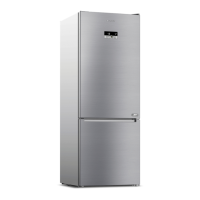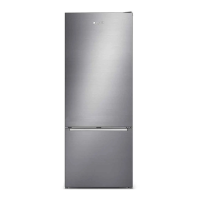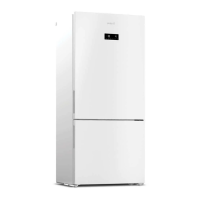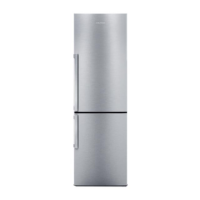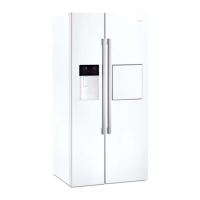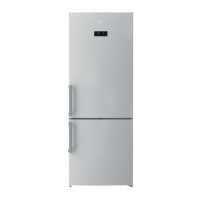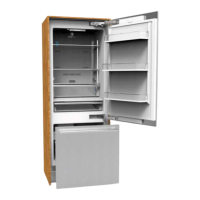Do you have a question about the arcelik 2485 and is the answer not in the manual?
Essential safety measures to prevent injury and damage during operation.
Specific precautions for refrigerators using R600a gas in the cooling system.
Safety guidelines for water dispenser models, including pressure limits.
Defines the proper usage and restrictions for the refrigerator.
Procedures to ensure children's safety around the appliance.
Compliance information for WEEE directive and waste product disposal.
Confirmation of adherence to RoHS standards for hazardous materials.
Details about the recyclability of product packaging.
Guidance on selecting an optimal and safe placement for the refrigerator.
Steps for fitting plastic wedges for proper air circulation.
Instructions for safely connecting the appliance to the power supply.
How to level the refrigerator by adjusting its feet for stability.
Information pertaining to the internal light source of the refrigerator.
Explanation of the optional alert for an open refrigerator door.
Guidelines and precautions for moving the refrigerator safely.
Tips for optimizing energy efficiency and reducing consumption.
Recommendations for effective food placement and sensor interaction in the fridge.
Details the refrigerator's indicator panel, its components, and basic functions with an initial diagram.
Explains the benefits of separate cooling systems for fresh and freezer compartments.
Provides guidelines for properly freezing fresh food to maintain quality.
Offers recommendations for storing and maintaining the quality of frozen foods.
Advises on the correct placement of various foods within the appliance compartments.
Highlights the importance of rapid freezing and low temperatures for food quality.
Instructions on using the optional ice machine to produce ice cubes.
Guidance on filling and operating the Icematic for ice production.
Steps for using the ice container to make and dispense ice.
Explains the blue light's role in preserving food freshness and vitamins.
Instructions for installing and correctly positioning the egg holder.
Describes how to clean the odor filter to prevent and eliminate bad smells.
Information on the snack compartment's purpose and recommended food storage.
Details the sliding container accessory for optimizing door shelf capacity.
How to use and move the rotary storage container for shelf access.
Explains the crisper's design for maintaining vegetable humidity and freshness.
Step-by-step guide on how to use the water dispenser.
Instructions for filling the water tank with clean drinking water.
Procedure for cleaning the water tank and dispenser components.
How to clean the drip tray that collects dispensed water.
Explains the humidity control feature for extending fruit and vegetable freshness.
Details the quick bottle cooling and ice making compartment and its usage.
Tips and methods for preventing and eliminating unpleasant odors inside the refrigerator.
Advice on cleaning plastic surfaces to prevent damage from spills and chemicals.
Common issues and solutions when the refrigerator fails to operate.
Troubleshooting condensation on side walls and its causes.
Solutions for problems related to the compressor not starting or running.
Addressing increased noise levels during refrigerator operation.
Diagnosing and resolving issues where the refrigerator runs for excessive periods.
Troubleshooting when freezer temperature is excessively low while cooler is adequate.
Troubleshooting when cooler temperature is excessively low while freezer is adequate.
Solutions for when food items in cooler drawers freeze unintentionally.
Addressing issues where the refrigerator or freezer temperature is too high.
Troubleshooting problems related to the product shaking or making noise.
Explaining normal operational noises like liquid flow and spraying sounds.
Explaining normal sounds produced by the cooling fan.
Troubleshooting condensation appearing on the internal walls of the appliance.
Addressing condensation on the exterior or between refrigerator doors.
Solutions for resolving bad odors originating from the refrigerator's interior.
Troubleshooting why the refrigerator door is not closing properly.
Solutions for a jammed vegetable bin or drawer.
Information about normal high temperatures on product surfaces during operation.
Essential safety measures to prevent injury and damage during operation.
Specific precautions for refrigerators using R600a gas in the cooling system.
Safety guidelines for water dispenser models, including pressure limits.
Defines the proper usage and restrictions for the refrigerator.
Procedures to ensure children's safety around the appliance.
Compliance information for WEEE directive and waste product disposal.
Confirmation of adherence to RoHS standards for hazardous materials.
Details about the recyclability of product packaging.
Guidance on selecting an optimal and safe placement for the refrigerator.
Steps for fitting plastic wedges for proper air circulation.
Instructions for safely connecting the appliance to the power supply.
How to level the refrigerator by adjusting its feet for stability.
Information pertaining to the internal light source of the refrigerator.
Explanation of the optional alert for an open refrigerator door.
Guidelines and precautions for moving the refrigerator safely.
Tips for optimizing energy efficiency and reducing consumption.
Recommendations for effective food placement and sensor interaction in the fridge.
Details the refrigerator's indicator panel, its components, and basic functions with an initial diagram.
Explains the benefits of separate cooling systems for fresh and freezer compartments.
Provides guidelines for properly freezing fresh food to maintain quality.
Offers recommendations for storing and maintaining the quality of frozen foods.
Advises on the correct placement of various foods within the appliance compartments.
Highlights the importance of rapid freezing and low temperatures for food quality.
Instructions on using the optional ice machine to produce ice cubes.
Guidance on filling and operating the Icematic for ice production.
Steps for using the ice container to make and dispense ice.
Explains the blue light's role in preserving food freshness and vitamins.
Instructions for installing and correctly positioning the egg holder.
Describes how to clean the odor filter to prevent and eliminate bad smells.
Information on the snack compartment's purpose and recommended food storage.
Details the sliding container accessory for optimizing door shelf capacity.
How to use and move the rotary storage container for shelf access.
Explains the crisper's design for maintaining vegetable humidity and freshness.
Step-by-step guide on how to use the water dispenser.
Instructions for filling the water tank with clean drinking water.
Procedure for cleaning the water tank and dispenser components.
How to clean the drip tray that collects dispensed water.
Explains the humidity control feature for extending fruit and vegetable freshness.
Details the quick bottle cooling and ice making compartment and its usage.
Tips and methods for preventing and eliminating unpleasant odors inside the refrigerator.
Advice on cleaning plastic surfaces to prevent damage from spills and chemicals.
Common issues and solutions when the refrigerator fails to operate.
Troubleshooting condensation on side walls and its causes.
Solutions for problems related to the compressor not starting or running.
Addressing increased noise levels during refrigerator operation.
Diagnosing and resolving issues where the refrigerator runs for excessive periods.
Troubleshooting when freezer temperature is excessively low while cooler is adequate.
Troubleshooting when cooler temperature is excessively low while freezer is adequate.
Solutions for when food items in cooler drawers freeze unintentionally.
Addressing issues where the refrigerator or freezer temperature is too high.
Troubleshooting problems related to the product shaking or making noise.
Explaining normal operational noises like liquid flow and spraying sounds.
Explaining normal sounds produced by the cooling fan.
Troubleshooting condensation appearing on the internal walls of the appliance.
Addressing condensation on the exterior or between refrigerator doors.
Solutions for resolving bad odors originating from the refrigerator's interior.
Troubleshooting why the refrigerator door is not closing properly.
Solutions for a jammed vegetable bin or drawer.
Information about normal high temperatures on product surfaces during operation.
| Model | 2485 |
|---|---|
| Category | Refrigerator |
| Energy Class | A+ |
| Number of Doors | 2 |
| Climate Class | SN-T |
| Refrigerant | R600a |
| Total Capacity | 248 liters |
| Refrigerator Capacity | 178 liters |
| Freezer Capacity | 70 liters |
| Freezer Net Capacity | 70 liters |
| Refrigerator Net Capacity | 178 liters |
| Total Net Capacity | 248 liters |
